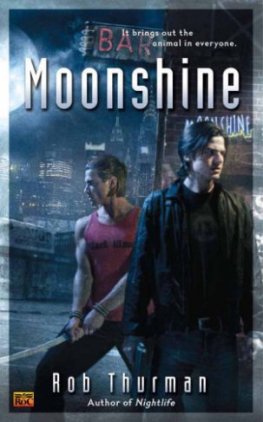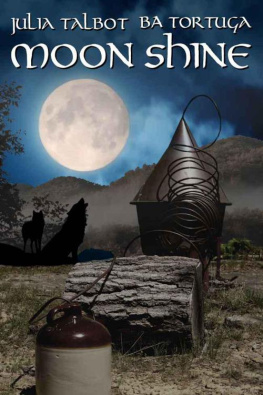MOONSHINE

Edible
Series Editor: Andrew F. Smith
EDIBLE is a revolutionary series of books dedicated to food and drink that explores the rich history of cuisine. Each book reveals the global history and culture of one type of food or beverage.
Already published
Apple Erika Janik Banana Lorna Piatti-Farnell
Barbecue Jonathan Deutsch and Megan J. Elias
Beef Lorna Piatti-Farnell Beer Gavin D. Smith
Brandy Becky Sue Epstein Bread William Rubel
Cake Nicola Humble Caviar Nichola Fletcher
Champagne Becky Sue Epstein Cheese Andrew Dalby
Chillies Heather Arndt Anderson Chocolate Sarah Moss
and Alexander Badenoch Cocktails Joseph M. Carlin
Curry Colleen Taylor Sen Dates Nawal Nasrallah
Doughnut Heather Delancey Hunwick Dumplings Barbara Gallani
Edible Flowers Constance L. Kirker and Mary Newman
Eggs Diane Toops Fats Michelle Phillipov Figs David C. Sutton
Game Paula Young Lee Gin Lesley Jacobs Solmonson
Hamburger Andrew F. Smith Herbs Gary Allen Honey Lucy M. Long
Hot Dog Bruce Kraig Ice Cream Laura B. Weiss Lamb Brian Yarvin
Lemon Toby Sonneman Lobster Elisabeth Townsend
Melon Sylvia Lovegren Milk Hannah Velten Moonshine Kevin R. Kosar
Mushroom Cynthia D. Bertelsen Nuts Ken Albala Offal Nina Edwards
Olive Fabrizia Lanza Onions and Garlic Martha Jay
Oranges Clarissa Hyman Pancake Ken Albala
Pasta and Noodles Kantha Shelke Pie Janet Clarkson
Pineapple Kaori O Connor Pizza Carol Helstosky
Pomegranate Damien Stone Pork Katharine M. Rogers
Potato Andrew F. Smith Pudding Jeri Quinzio Rice Renee Marton
Rum Richard Foss Salad Judith Weinraub Salmon Nicolaas Mink
Sandwich Bee Wilson Sauces Maryann Tebben Sausage Gary Allen
Seaweed Kaori OConnor Soup Janet Clarkson
Spices Fred Czarra Sugar Andrew F. Smith Tea Helen Saberi
Tequila Ian Williams Truffle Zachary Nowak
Vodka Patricia Herlihy Water Ian Miller
Whiskey Kevin R. Kosar Wine Marc Millon
Moonshine
A Global History
Kevin R. Kosar
REAKTION BOOKS
To my family, an endless source of amazement and amusement, and to Eli Lehrer and my awesome colleagues at the R Street Institute the Washington, DC, think-tank that welcomed me to the team in late 2014.
Published by Reaktion Books Ltd
Unit 32, Waterside
4448 Wharf Road
London N1 7UX, UK
www.reaktionbooks.co.uk
First published 2017
Copyright Kevin R. Kosar 2017
All rights reserved
No part of this publication may be reproduced, stored in a retrieval system, or transmitted, in any form or by any means, electronic, mechanical, photocopying, recording or otherwise, without the prior permission of the publishers
Page references in the Photo Acknowledgements and
Index match the printed edition of this book.
Printed and bound in China by 1010 Printing International Ltd
A catalogue record for this book is available from the British Library
eISBN: 9781780237909
Contents

Policemen pose with a haul of confiscated moonshine, Washington, DC, during Prohibition.
Introduction: Moonshine, Moonshine Everywhere

Although decades have passed, I still remember my first experience with moonshine, albeit vaguely. I was in the basement of a university fraternity house, and another person whom I did not know very well produced a Mason jar. The contents were as clear as water. He said that a relative had brought it to him from his home state of West Virginia, which is famous (or notorious, depending on ones perspective) for the production of illegal spirits.
He unscrewed the jar and handed it to another guy, whose face bunched up after a single sniff. When I nosed the bottle, my head snapped backwards the vapours burned my nasal passages and my eyes immediately watered; I felt fear. I was not new to alcoholic beverages, but this booze struck me as dangerous. Who had made it? I wondered. What proof was it? Might we go blind drinking it? Nonetheless, we each agreed to do one shot of the shine, as the purveyor termed it. This lone shot soon became a few. The drink had a terrible chemical taste, and I had to fight against my gag reflex to get each small gulp down my throat. Some time after, loud music was turned on, and we all began leaping about. A friends elbow went through the plasterboard ceiling. Quite probably we staggered to a bar. I honestly cannot recall.
One might ascribe that moonshine incident to a unique youthful episode. If only. Nearly anywhere I go, if I raise the topic of moonshine I will find someone who knows about it or has drunk it. Twenty-five years after my moonshine initiation, I found myself in a very different setting. It was a book party for a dear friend who had recently passed away. We had assembled in the ballroom of the Metropolitan Club, founded in 1863 in downtown Washington, DC. The club is an opulent space: ornate chandeliers hang from soaring ceilings, and moustached military men glower from gilt frames at anyone standing on the lush oriental rugs that cover the hardwood floor. Club members have included U.S. presidents, Supreme Court justices and manufacturing moguls. Today it is a haven for bankers and lawyers, those who can afford the membership fees and abide by its jacket-and-tie-at-all-times dress code. While at the party, I struck up a conversation with an older gentleman who once worked with my late friend. We reminisced about the deceased and toasted him with crystal tumblers of pricey bourbon. The subject of research and writing arose, and I mentioned I was working on this book. Oh, moonshine yes, I know something of that, he said with a sly smile. As a college student in the early 1960s, he and his friends drank moonshine that they acquired from a local restaurant: The waitress would ask if you were thirsty and give you a wink, and if you winked back properly, shed add a charge to your bill. When you went to your car after the meal, a bottle of moonshine would be under your seat. I inquired whether the booze was any good. It was rough, he admitted. But it was a dry county. You could not buy liquor. We could drive to other places in the state and buy liquor legally. But buying moonshine this way was half the fun.
Growing up in the United States, I got the impression that moonshine was a peculiarly American phenomenon. Moonshine itself just sounded like an American term. The television show The Dukes of Hazzard (197985) and popular lore served up a simple story. Moonshiners live in Americas mountains and back roads. Honest, simple country folk, moonshiners make likker from cherished family recipes. They are, the story goes, poor people whose days are spent trying to outfox the police so as to carry on the traditions of their forebears and earn a living by selling white lightning to their friends and neighbours, and the occasional curious collegiate.













